As with any war in history, the Russo-Japanese War enjoys its share of myths and legends that range from Admiral Alekseev’s barber being a Japanese spy, to the saga of the Baltic Fleet becoming the “fleet that had to die.” Perhaps because of such legends, or perhaps because World War I broke out less than a decade after the Russo-Japanese War formally ended with the Treaty of Portsmouth in 1905, the centennial anniversary of Japan’s stunning victory witnessed a resurgence in Russo-Japanese War studies. Always considered a bilateral engagement between two military powers, which it was in its most basic sense, the Russo-Japanese war also had a significant global impact.
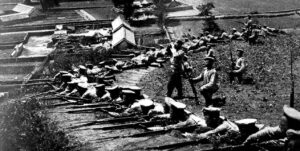
Although the idea is controversial, the Russo-Japanese War could be considered “World War Zero” for a host of reasons, beginning with the newly developed capacity of industrialized powers to wage war on an unprecedented scale on Far Eastern battlefields and oceans.1 The debate that emerged over the concept of World War Zero underscores the significance of the Russo-Japanese War to twentieth century history, in that a fundamental question emerges: was the conflict that occurred between Russia and Japan a precursor to World War I, and, as such, the original example of the type of conflict that occurred in the first half of the twentieth century?2 In its broadest sense, the age of Imperialism reached its apex between 1904 and 1905 when Russia, a traditional European power, confronted Japan, the rising Asian power, in China and Korea, both self-proclaimed and internationally recognized neutral countries. The impact of Japan’s military victories, and likewise, Russia’s defeat, therefore, marked the beginning of a new century now commonly accepted as the era of total global conflict. The outcome of this war redefined international relations in a way that fostered a series of conflicts, culminating in the second half of the twentieth century with the globalization of the world.
At the root of this question rests the issue of why the Russo-Japanese War occurred at all. Not surprisingly, the war was a product of its time. Both Russia and Japan had imperial ambitions over the territories where they fought—Manchuria and Korea. For the Russians, expansion into Manchuria was the continuation of a policy that can be traced back as far as the reign of Ivan the Terrible, or to as recently as the nineteenth-century Imperial government’s colonial policy. In the course of building an empire through Central Asia and into the Far East, the gulf between the tsar and Russian society widened and became irreparably compromised, but the war in 1904 was greeted with an outburst of patriotic support! Nicholas II, who could not afford to ignore the growing chasm between his autocracy and Russian society, squandered this support through his reckless system of governance. His inability to firmly control the empire’s policy of expansion into the Far East aptly demonstrated why everyone—from peasants, to educated society, to aristocrats—lost confidence in their tsar, particularly after he foolishly stumbled into conflict with Japan.
Japan’s rise to prominence among nations, however, had been nothing short of spectacular. Without an industrial revolution or any form of participatory political franchise when Commodore Perry’s great black fleet arrived in Edo Bay on July 8, 1853, Japan found itself vulnerable to the power politics of the Great Powers at the apex of the Age of Imperialism. From this point on, the Japanese, understanding the confrontational politics of the Western world, sought to maintain their autonomy by evading the grasp of imperialism and colonialism. The 1868 Meiji restoration became the Japanese response to the challenges of the modern world. Throughout the second half of the nineteenth century, Japan embraced all of the scientific, technical, and political know-how of the West that their leaders deemed appropriate. When they defeated the Chinese in the 1894–95 Sino-Japanese War, the Japanese believed they had made a convincing case to be accepted as the great power in Asia. Even after being manhandled by Great European Power politics in the aftermath of the treaty of Shimonoseki by being forced to give up the Liaodong Peninsula, the Japanese maintained their convictions about their perceived place in the world: They were going to have their own empire and not become a colonial possession of a Western power.
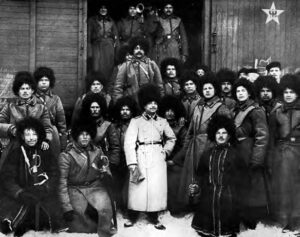
http://ocw.mit.edu/ans7870/21f/21f.027/throwing_off_asia_03/toa_vis_02.html.
Studies that focus on the impact of the Russo-Japanese War on the culture of both nations, as well as other regions of the world, provide revealing views of how this conflict contributed to the development of early twentieth century global society. To accept the notion of the Russo-Japanese War as World War Zero, it must also be seen as a “total war,” a twentieth century phenomenon that affects every aspect of a nation’s economic, cultural, and political life, and, once hostilities cease, has a transforming impact on the politics and societies of both belligerents. The idea of “total war,” of course, is not new to the history of conflict. The idea can be dated back at least to the age of the French Revolution and Napoleon, if not even further back to the Thirty Years War and Gustavus Adolphous’ military revolution.3 Indeed, the nineteenth century was littered with short wars and confrontations related to the larger goals of national unification or imperial expansion.
The Russo-Japanese War seems less like a short imperial war, and similar to later “total wars,” due to a host of factors that include the relationship of the front to the rear, the lethal killing fields that became its zone of combat, and methods used to fund a war in Manchuria on the London, Paris, and New York financial markets. In this regard, the Russo-Japanese War looked more like World War I than anything that had occurred previously, including the Spanish-American and Boer Wars. With this fact as an essential historical precedent, appreciating the broad impact of the Russo-Japanese War on the belligerent nationals, as well as on the history of the world, heightens the understanding of the war, not only in military and political, but also in social and cultural terms.4
From the time it began, military observers, journalists, and analysts, and later on military historians, treated the Russo-Japanese War as a regional conflict that resulted in an unexpected outcome. At first, they downplayed the lessons that could be learned from the after-action studies of a war because the war was fought on the other side of the world between a weak great European power and a rising Asian nation. Then, these same lessons became a part of the history of the war whose size, scope, and significance paled in comparison to the carnage of World War I. But, the legacy of the war weighed heavily on world history. Even if everyone failed to grasp the immediate lessons to be learned from the new, more lethal twentieth century battlefield, and its subsequent impact on political history, the victory of the Japanese forever transformed the image that people of color, the colonized people of the world, had of their Imperial masters. Japan’s victory started them down the road of creating an Asia for Asians, while the people of Asia recognized that a new military power had asserted its authority in their region of the world.
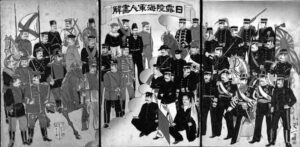
The failure of the Great European Powers to act on the lessons of the Russo-Japanese War in a timely fashion is testimony to the folly of the politicians and nations during the Belle Epoch. In military terms, all of the belligerents combined mobilized over 2.5 million men and armed them with sophisticated weapons, which were the product of late nineteenth century industrial production. Not only were the standards of these weapons superior to any previously used in the history of warfare, but they also could be made available to military establishments in greater numbers than ever before. This alone required the management of resources to a degree unprecedented in the history of the civil-military matrix. It revealed the need for professional management on every level, from the acquisition and production of raw materials and equipment, to the recruitment, training, supply, and command of soldiers. By necessity, the requirements of this “modern” battlefield forged a relationship between the military front and the civilian rear closer than anyone had considered possible at the beginning of the nineteenth century. In fact, by the beginning of the twentieth century, the marvels of the Industrial Revolution had pitched warfare to a higher level; to wage war necessitated a firm relationship between the government, industry, and the rest of the economy.
The early twentieth century battlefield proved to be far more lethal than ever before. This heightened killing power was a direct result of the development of modern armaments, ranging from rapid-firing artillery, to machine guns, and more accurate carbines. Most army commanders envisioned using these weapon systems to dominate the battlefield on an operational and tactical level, as Moltke had accomplished at Sedan. What they got in 1904–05 was something the strategic planners had not envisioned: prolonged engagements that lasted for days across large-scale (in geographic terms) battlefields; engagements that, in the end, produced massive casualties rather than decisive victory. The revolution in military armaments also transformed the capabilities of navies. With the construction of iron-clad, steam-driven ships with large-caliber guns and heavy armaments, the immediate precursors to the HMS Dreadnought, the navies of the Great Powers believed they had the capabilities to fight a decisive battle in Mahanian terms, one that would culminate with the victorious power dominating the sea.5 Whether it was through the introduction and development of naval mines and torpedoes, or through greater communication (telegraph) and transportation (railroads) capabilities, science also played a decisive role in restructuring battlefields in the twentieth century. Be it on land or on sea, greatly enhanced twentieth-century military capabilities first appeared on the Liaodung Peninsula, and in the Yellow Sea, and the Sea of Japan, the theater of operations of the Russo-Japanese War.
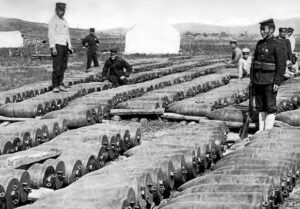
http://ocw.mit.edu/ans7870/21f/21f.027/throwing_off_asia_03/toa_vis_02.html.
The actual military engagements of the Russo-Japanese War, however, are not what allow us to refer to the conflict as World War Zero. The Manchurian War of maneuver that started with the Japanese invasion of Korea on February 9, 1904, and effectively concluded approximately one year later with the battle of Mukden: the surprise attack on and siege of Port Arthur; the Battle of Tsushima—all of these events did indeed occur, after all, within a confined region of the world. Ironically, the war was fought in China and Korea, two neutral countries who found themselves embroiled in a conflict between imperial powers. What makes this war different from the German Wars of Unification, or the more recent Spanish-American and Boer wars, was the scope of international involvement that occurred during and after the conflict.
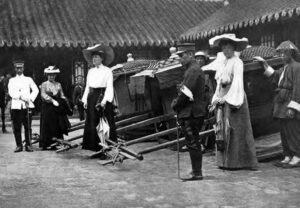
While the international community strove to maintain neutrality throughout the war, all of the European powers were implicated, in one fashion or another, because of treaty obligations to either Russia or Japan. No event made this clearer than the saga of Russia’s Baltic Fleet, soon to be known as the Second Pacific Squadron, as it plodded its way out of the Baltic and North Seas, not to neglect the incident in the English Channel, and then meandered around the globe on its 18,000 mile trek. The progress of this fleet, including the efforts to keep it in fuel and other provisions, made it a cause célèbre in the press and for international readers. More to the point, however, was how each side managed to finance the war. Be it through French loans to Russia, or Japanese loans from a syndicate of British and/or American bankers, the belligerent nations needed to reach outside of their own resources to finance this conflict. The demands of the industrialized battlefield made the cost of war skyrocket. Warring nations in the aftermath of the Russo-Japanese War were going to have to develop credit lines to finance future conflict. This opened the door for bankers to have an impact on international events. The Americans, led by Jacob H. Schiff, decided to support the Japanese in response to Russia’s persecution of its Jews. And when this same syndicate, using its own intelligence-gathering capabilities, understood that the Japanese had run out of men after the Battle of Mukden (February–March, 1905), it cut off loans to Japan, and effectively ended that country’s capability to wage war on land.
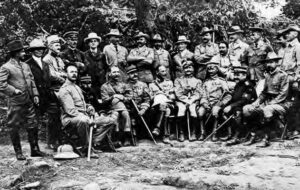
An even more poignant testament to the global implications of the war was how it ended. While the Russian army and navy lost all of their significant battles, after Mukden, the Japanese could only wait for the tsar to decide when he was going to call it quits. Nicholas II had a second fleet churning up the seas as it sailed to the Far East, and while it took from February 1904 until May 1905 to accomplish the task of reinforcing his armies in Manchuria (because of the limitation of the Trans-Siberian railway), by spring 1905, the Imperial Russian forces had a sizable numerical advantage over the Japanese in Manchuria. However, the reliability of this force was questionable because of the 1905 Revolution and the mutiny that had spread throughout Russia’s armed forces, so Nicholas II waited for the outcome of the naval battle before determining his next move. Ironically, the Battle of Tsushima proved to be the major naval engagement between early twentieth century battleships, and its decisive outcome, combined with the serious threat of domestic revolution, forced Nicholas II to the peace table. The tsar refused to acknowledge defeat, but he also could no longer afford to fight because of domestic concerns. And as a result, he insisted that he would not pay any indemnities, which set the stage for the peace negotiations that occurred in Portsmouth, New Hampshire in September, 1905.
But why would a war fought in two neutral Asian countries between a European Great Power and an emerging Japan be resolved in the United States? Of course, the role of President Theodore Roosevelt, who won the Nobel Prize for his efforts, cannot be underestimated in evaluating a response to the role of the US in the peacemaking (or is it war termination?) that occurred in 1905. But, the events at Portsmouth clearly marked another significant step in the rise of the United States as a Pacific power. After courting the Japanese, Roosevelt decided to support the tsar’s refusal to pay indemnities, a move that policymakers in Tokyo interpreted as signifying that the US had more than a passing interest in Asian affairs. Indeed, the argument can be made that the conduct of the United States during the treaty negotiations that ended the Russo-Japanese War not only contributed to the broader recognition of its growing role in the Pacific, but also started US and Japanese policymakers down the road that resulted in Pearl Harbor and culminated at Hiroshima and Nagasaki.
C
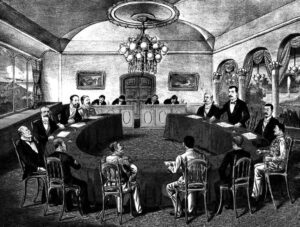
ontributing to this growing and new international system was the emergence of transnational and non-governmental organizations such as the Red Cross. While not born out of the Russo-Japanese War, the Red Cross did make its presence felt in the region of conflict. Because this war was fought on neutral territory, the belligerents did not consider themselves responsible for the displaced people who became victims of their conflict. After all, Chinese and Korean people were not subjects of the Russian or Japanese emperor. With the emergence of a massive refugee problem, the Chinese government, in particular, needed assistance—as did both of the belligerents. Simply put, no one anticipated the tens of thousands of dead and even more wounded that resulted from the conflict, thanks to modern weapons. As a result, neither the Russians nor the Japanese had the medical facilities to cope with the scale of this human catastrophe. In this situation, non-governmental agencies that transcended nations and regions found a place where they were needed. Their role, first defined during the Russo-Japanese War, would continue throughout the twentieth and into the twenty-first century. Their existence symbolized the beginning of the melting of civilizations through the identity of common problems and challenges, and they would become more necessary as the twentieth century progressed.
Along with the emergence of non-governmental organizations, a new Asia/Pacific regional order also grew out of this conflict. Japan, as the rising Asian power, had demonstrated that its military establishment could tangle with a European Great Power and emerge victorious. Its military victory, combined with its defeat of China in the 1894–95 Sino-Japanese War, revealed not only the political and economic weakness of the Manchu dynasty, but also Japan’s willingness and readiness to take an active and leading role in Asian affairs. Such Japanese activism made a widespread contribution to emerging nationalism across the region. Aggravating persistent European imperial encroachment across Asia was the ever-growing strength of the United States, which represented a developing threat to the autonomy of the region. US-Japanese relations would go through a period of rapprochement in the early twentieth century, but by the Washington Naval Conference of 1922, few in Japan believed that the United States meant anything positive for the future of Asia. By the 1930s, the presence of the United States in Asian affairs, combined with the turmoil in China and the collapse of the Western economic order, resulted in Japan’s aggressive action in China and the rhetoric that ultimately culminated in the Greater East Asian Co-Prosperity Sphere. While there were many steps in-between, one can argue that Japan’s road to World War II began not when it won the Russo-Japanese War, but when it lost the peace.6
The Russo-Japanese War, therefore, had all of the elements that historians have discerned in World War I. Its origins were linked to the imperial expansion of the European powers, its battlefields were stocked with the weapons and munitions of the industrial revolution, and neither the civilian nor the military leadership were prepared for the war that actually occurred in Manchuria. When hostilities ceased, both countries faced dire financial and political consequences, and non-governmental agencies were needed to aid victims and restore a semblance of stability to the region where the conflict was fought. Moreover, the peacemaking process at Portsmouth, like the events that would occur at Versailles in 1919, would leave as many issues unresolved as solved, thereby planting the seeds for future conflict. Historians may argue among themselves over the viability of the Russo-Japanese War as World War Zero, and the arguments both pro and con will remain persuasive. What cannot be questioned, however, is that the Russo-Japanese War was a modern twentieth-century conflict that offers much evidence revealing the direction in which the policies of the Great Powers, both internal and external, were taking the rest of the world. Sadly for the development and progress of modern civilization, little good can be said for the culmination of these policies, since they were, in fact, the introduction to the century of total conflict, the twentieth century.
- The idea of the Russo-Japanese War as World War Zero was first presented in John W. Steinberg, et al., The Russo-Japanese War in Global Perspective: World War Zero, vol.1 (Leiden, 2005).
- The parameters of the debate were recently highlighted in two book reviews of the Steinberg, et al. publication on the war. These reviews are located in: Russian Review 65 (October 2006), 705–707 and Slavic Review 65 (Winter 2006), 824–25.
- While the bibliography is immense, see: William McNeill, The Pursuit of Power: Technology, Armed Forces, and Society since A.D. 1000 (Chicago: University of Chicago Press, 1982); more specifically, see R. Chickering, “Total War: The Use and Abuse of a Concept,” in Manfred F. Boemeke, Roger Chickering, and Stig Forster (eds.) Anticipating Total War: The German and American Experiences, 1871–1914 (Washington D.C.: German Historical Institute, 1999), 13–28; and J.Y. Guiomar, L’invention de la guerre totale (Paris: Le Felin, 2004).
- An earlier effort to note the cultural impact of the war should be noted here. See David Wells and Sandra Wilson, eds., The Russo-Japanese War in Cultural Perspective, 1904– 05 (New York: St. Martins Press, 1999).
- Alfred Thayer Mahan was a US Naval Officer whose ideas about the use of sea power had an international impact on early twentieth century Naval strategy.
- On the issues of the rise of non-governmental agencies and Asian nationalism/regionalism, see Iriye Akira’s introduction to: David Wolff, et al., ed. The Russo-Japanese War in Global Perspective: World War Zero, II (Leiden: Brill, 2007), 1–13.

